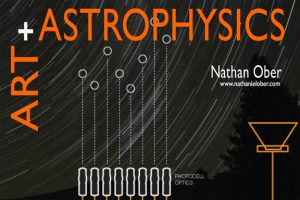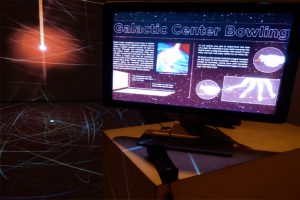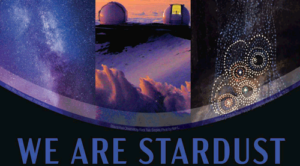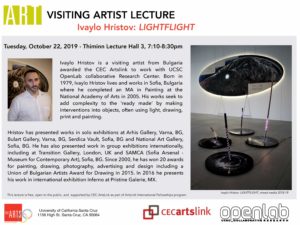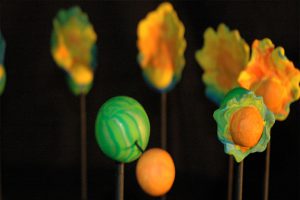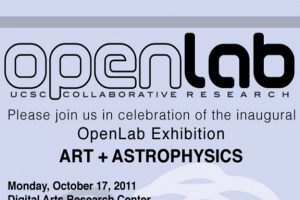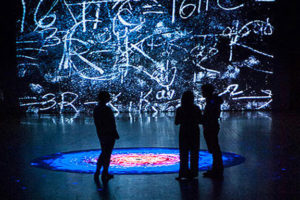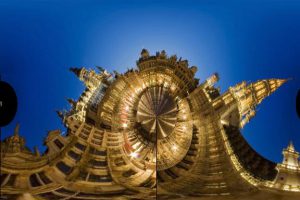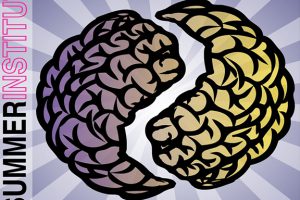
Art + Astrophysics Lab
The lab works closely with OpenLab founding Professors Enrico Ramirez-Ruiz and Jennifer Parker with support from the UCSC NSF REU- Lamat Summer Research Program, OpenLab, and the SLUG: Supercomputer lab for Undergraduates.
Hubble Space Telescope, Keck Adaptive Optics Imaging, and Keck Spectroscopy of Variable Stars in Andromeda Star Clusters
The Andromeda galaxy (M31), a galaxy similar to our own, is rich with star formation in globular and open clusters. Due to the vast amount of data on these star clusters, this project has three main focuses: processing raw adaptive optics images, comparative analysis of Keck adaptive optic images and Hubble images and visualization of data products and results
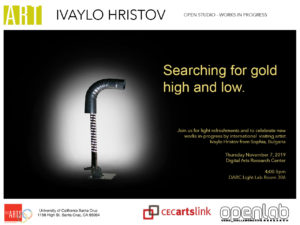
Open Studio with Ivaylo Hristov: Searching for Gold High & Low
This exhibition features new works-in-progress by Ivaylo Hristov, CEC ArtsLink visiting artist-in-residence from Bulgaria in UCSC OpenLab. Hristov has created a wonderful site-specific exhibit that includes, visor, drawing, painting and text. Works are explorations of the California light, land, and sky searching for gold at the university. Many works in the exhibit are based on his interactions and conversations artists & scientists during his residency. Please join us for lite refreshments and a celebration.
Nathan Ober is a DANM graduate student developing creative research projects for the Art + Astrophysics Lab in the Digital Arts Research Center this summer at UCSC.
Galactic Bowling - Tidal Disruption of Stars: Game like Wiimote triggered visualization created by one of the OpenLab Summer Institute teams of Art and Science at the University of California Santa Cruz. Lyes Belhocine, DANM Research Associate Drew Detweiler, DANM Research Associate James Guillochon, Astrophysics Graduate Student Morgan MacLeod, Astrophysics Graduate Student Uliana Popov, Engineering Graduate Student Enrico Ramirez-Ruiz, UCSC Astronomy and Astrophysics Faculty Jolie Ruelle, DANM Graduate Student/Summer Art Lecturer
Native Skywatchers – Starry, Starry Nights Collaboration: We Are Stardust
Professors Annette Lee and Professor Raja GuhaThakurta
As described by Mi’kmaw elders: “Two-Eyed Seeing is learning to see from one eye with the strengths of Indigenous knowledges and ways of knowing, and from the other eye with the strengths of Western knowledges and ways of knowing, and to use both these eyes for the benefit of all” (Bartlett, Marshall, and Marshall 2012, 336). This collaboration will follow in the spirit and framework of Two-Eyed Seeing, with particular emphasis on the last line ‘use both these eyes for the benefit of all’. It builds on the existing Native Skywatchers research and programming initiative in a unique merger with the Starry, Starry Nights initiative. The goal is to give students a unique opportunity for authentic involvement in science and to weave in cultural relevance equally into the experience to produce the highest level of engagement, excitement, and meaning for all involved. This project lives at the intersection of science, art, and culture.
Visiting Artist-in-Residence Explores Connections with Art & Astrophysics
MoonSplat! The model for OpenLab’s 3D stroboscopic zoetrope, is a series of physical models created by sculptor Leslie Thompson with Sudhu Tewari from computer simulations of an impact between the moon and a smaller companion.
MoonSplat – Tidal Disruption
OpenLab opening reception with presentation by artists and scientist who collaborated on the Arts + Astrophysics Exhibition.
Join the 3D VizLab for an open house at the 3D Astrophysical Visualization Laboratory (a.k.a. the 3D VizLab), where we will be presenting a range of 3D scientific visualizations, both on our 3D TV and our virtual-holographic workstation, zSpace.
"The idea of OpenLab is simple: Bring together a group of specialists from different disciplines and task them with leveraging each other’s strengths to create new ways to visualize scientific research."
Black (W)hole is an immersive exhibition experience designed by The Einstein Collective that combines the arts, data visualization and sonification, and astrophysics. Entering the installation, viewers step into a darkened gallery where a laser star field projects onto their skin.
The Astro Lounge was developed by OpenLab summer research fellows Zach Corse and Nathan Ober as members of OpenLab's 2015 Art + Astrophysics' Summer Institute. New works emerged from their interest in Einstein's theory of general relativity and its many applications, information theory, and the limits of human perception.
ART + Astrophysics Exhibition. The exhibition feature four exhibit of astrophysical phenomena including Black Hole/Star Bowling Game; a Kepler App; a 3D Zoetrope of MoonSplat, and an interactive sculpture of Spectral Shifts in the Milky Way.
The Kepler App and Display Case were developed through the OpenLab initiative at UC Santa Cruz, which brought together faculty and students in astrophysics, art, and technology for a summer institute last year. The Kepler Explorer team includes astrophysicist Jonathan Fortney, a member of the Kepler science team; two of his graduate students, Eric Lopez and Caroline Morley; artist Kyle McKinley, a recent graduate of the Digital Arts and New Media program; and John Peters, a recent graduate of the computer game design program.m
Black Star/Digital Star was developed by Eddie Lee in response to an OpenLab open-call for the TRANSMUTATION project with SonicSENSE at Gray Area. Lee is a graduate from the Guildhall at SMU, where he received his Masters in Interactive Technology.


